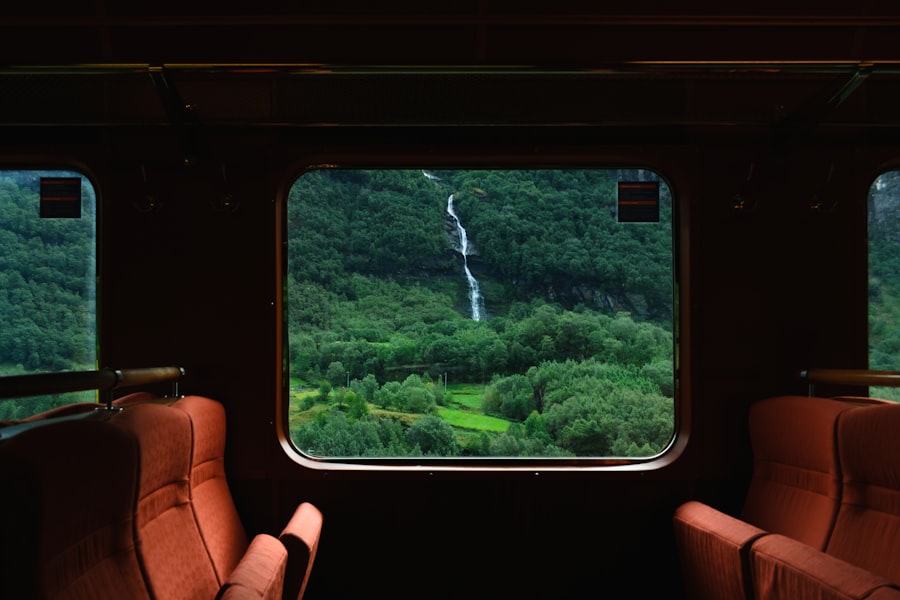Norway’s winter season is a captivating yet challenging time, characterised by its stunning landscapes blanketed in snow and the ethereal glow of the Northern Lights. However, the beauty of this season comes with its own set of difficulties, particularly for those who are not accustomed to driving in such conditions. The winter months, typically spanning from late November to early April, can bring about severe weather changes, including heavy snowfall, icy roads, and reduced visibility.
Understanding these conditions is crucial for anyone planning to navigate Norway’s roads during this time. The geographical diversity of Norway means that winter conditions can vary significantly from one region to another. Coastal areas may experience milder temperatures and more rain, while inland regions can be subjected to extreme cold and substantial snowfall.
Additionally, the northern parts of the country often face polar nights, where daylight is scarce. This lack of light can further complicate driving conditions, making it essential for drivers to be well-prepared and informed about the specific weather patterns in the areas they intend to travel. Book your 1-hour strategy session with Norway Relocation Group.
Summary
- Winter conditions in Norway can be extreme, with heavy snowfall, icy roads, and limited daylight hours.
- Preparing your vehicle for winter driving in Norway is essential, including checking the battery, antifreeze levels, and tyre tread depth.
- Safe winter driving in Norway requires adjusting your speed, increasing following distance, and using headlights at all times.
- Understanding road signs and conditions in Norway is crucial for navigating through the winter landscapes, including being aware of potential hazards and road closures.
- Dealing with snow and ice on the roads in Norway requires using snow chains, driving with caution, and avoiding sudden movements.
Preparing Your Vehicle for Winter Driving
Before embarking on a winter journey in Norway, it is imperative to ensure that your vehicle is adequately prepared for the harsh conditions. This preparation begins with a thorough inspection of your car, focusing on essential components such as the battery, brakes, and lights. Cold temperatures can significantly affect battery performance, so ensuring that your battery is in good condition is vital.
Additionally, checking your brakes and lights will help ensure that you can stop safely and be seen by other drivers in low visibility conditions. Equipping your vehicle with the right accessories is equally important. A winter emergency kit should be a staple in your car during this season.
This kit should include items such as a shovel, ice scraper, warm blankets, a first-aid kit, and non-perishable snacks. Furthermore, ensuring that your fuel tank is kept at least half full can prevent fuel line freeze-up and provide extra weight for better traction on slippery roads. Taking these steps will not only enhance your safety but also provide peace of mind as you navigate Norway’s winter roads.
Tips for Safe Winter Driving in Norway

Driving safely in winter conditions requires a different mindset and approach compared to driving in milder weather. One of the most critical tips is to reduce your speed. Icy roads can significantly increase stopping distances, so maintaining a slower speed allows for better control of your vehicle.
Additionally, increasing the distance between your car and the vehicle in front of you is essential; this extra space provides more time to react if sudden stops are necessary. Another vital aspect of safe winter driving is being aware of your surroundings. This includes keeping an eye out for black ice, which can form unexpectedly on roads, especially in shaded areas or during early morning hours.
It is also advisable to avoid sudden movements with the steering wheel or brakes, as these can lead to skidding. Instead, gentle acceleration and deceleration will help maintain traction and control. By adopting these practices, drivers can significantly reduce their risk of accidents during Norway’s winter months.
Understanding Road Signs and Conditions
Navigating Norway’s roads requires familiarity with various road signs and conditions that are particularly relevant during winter. Many signs indicate potential hazards such as slippery roads or areas prone to avalanches. Understanding these signs is crucial for making informed decisions while driving.
For instance, a sign indicating “glatte veier” (slippery roads) serves as a warning to reduce speed and exercise caution. Moreover, it is essential to be aware of changing road conditions that may not be immediately apparent. Snow accumulation can obscure lane markings, making it difficult to determine the correct path.
In such cases, relying on road signs becomes even more critical. Additionally, understanding local traffic regulations regarding winter driving can help avoid fines and ensure compliance with safety standards.
Dealing with Snow and Ice on the Roads
When faced with snow-covered or icy roads, drivers must adopt specific techniques to navigate safely. One effective method is to steer into a skid if your vehicle begins to slide. This means turning the steering wheel in the direction you want the front of the car to go.
It may feel counterintuitive, but this technique can help regain control of the vehicle. In addition to steering techniques, it is crucial to understand how to brake effectively on slippery surfaces. Instead of slamming on the brakes, which can lead to loss of control, applying gentle pressure can help slow down without causing skidding.
If you find yourself stuck in deep snow, rocking the vehicle back and forth by shifting between drive and reverse can help free it from its predicament. These strategies are essential for maintaining safety while traversing Norway’s winter roads.
Understanding the Importance of Winter Tires

One of the most significant factors influencing winter driving safety in Norway is the use of appropriate tyres. Winter tyres are specifically designed to provide better traction on snow and ice compared to standard tyres. Their unique tread patterns and rubber compounds remain flexible in cold temperatures, allowing for improved grip and handling.
In Norway, it is not just advisable but often legally required to equip your vehicle with winter tyres during the winter months. The importance of winter tyres cannot be overstated; they significantly reduce stopping distances on icy surfaces and enhance overall vehicle stability. It is also worth noting that some regions in Norway may have specific regulations regarding tyre usage, including studded tyres that provide additional grip on icy roads.
Familiarising yourself with these regulations will ensure compliance and contribute to safer driving experiences throughout the winter season.
How to Handle Emergency Situations on the Road
Despite careful preparation and adherence to safety guidelines, emergencies can still occur while driving in winter conditions. Knowing how to respond effectively can make a significant difference in ensuring your safety and that of others on the road. If you find yourself involved in an accident or experiencing vehicle failure, it is crucial to remain calm and assess the situation before taking action.
If your vehicle becomes immobilised due to snow or ice, it is essential to stay with your car unless help is nearby or you are certain you can reach safety without risking exposure to the elements. Keeping your hazard lights on will alert other drivers to your situation. If you need assistance, using a mobile phone or emergency roadside service can help you get back on track quickly and safely.
Understanding the Law and Regulations for Winter Driving
Norway has specific laws and regulations governing winter driving that all motorists must adhere to for their safety and that of others on the road. One key regulation mandates the use of winter tyres during certain months when conditions warrant their use. Failure to comply with this law can result in fines or penalties, making it essential for drivers to stay informed about local regulations.
Additionally, there are laws regarding speed limits and safe driving practices during adverse weather conditions. It is crucial for drivers to adjust their speed according to road conditions rather than solely relying on posted speed limits. Understanding these laws not only helps avoid legal repercussions but also promotes a culture of safety on Norway’s roads during winter.
Navigating Through Norway’s Winter Landscapes
Driving through Norway’s winter landscapes can be an awe-inspiring experience filled with breathtaking views of snow-capped mountains and frozen fjords. However, navigating these picturesque routes requires careful attention and respect for nature’s power. Many scenic routes may become treacherous during winter months due to snow accumulation or avalanches.
When planning a journey through these stunning landscapes, it is wise to check weather forecasts and road conditions beforehand. Some routes may be closed due to heavy snowfall or other hazards, so staying informed will help avoid unexpected detours or delays. Embracing the beauty of Norway’s winter scenery while remaining vigilant about safety will ensure a memorable experience.
Tips for Driving in Urban Areas during Winter
Driving in urban areas during winter presents its own unique challenges compared to rural settings. Cities often have higher traffic volumes, which can lead to congestion on icy roads. It is essential for drivers to remain patient and allow extra time for their journeys during this season.
Additionally, urban areas may have more frequent instances of black ice due to traffic patterns and heat from buildings. In cities like Oslo, where public transport options are abundant, considering alternative modes of transportation during severe weather may be wise. If you must drive, ensure that you are familiar with local parking regulations and any restrictions that may apply during winter months.
By being mindful of these factors, drivers can navigate urban environments more safely during Norway’s winter season.
Resources for Further Assistance and Information
For those seeking additional information about winter driving in Norway, numerous resources are available to assist both residents and visitors alike. The Norwegian Public Roads Administration provides valuable insights into road conditions, weather forecasts, and safety tips tailored specifically for winter driving. Furthermore, local driving schools often offer courses focused on winter driving techniques that can enhance skills and confidence behind the wheel during challenging conditions.
For those looking to immerse themselves further into Norwegian culture while learning the language necessary for effective communication on the road, consider enrolling in Norwegian courses at the NLS Norwegian Language School in Oslo. These courses not only teach language skills but also provide cultural insights that can enrich your experience while navigating Norway’s beautiful yet demanding winter landscapes. In conclusion, understanding winter driving conditions in Norway requires preparation, awareness of regulations, and respect for nature’s challenges.
By equipping yourself with knowledge and skills tailored for this unique environment, you can enjoy safe travels through one of the world’s most stunning winter wonderlands.
Speak Norwegian with confidence. Enroll in a class at the NLS Norwegian Language School now.

